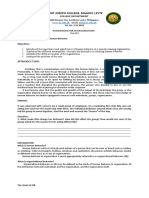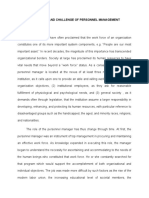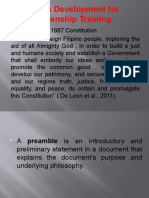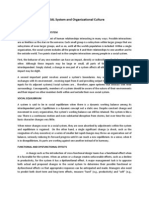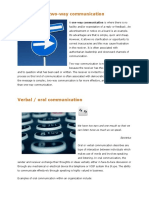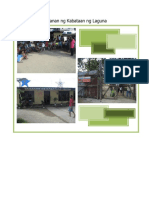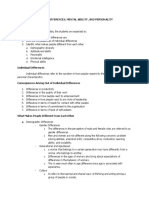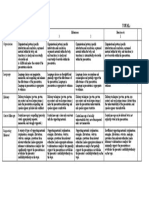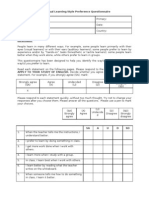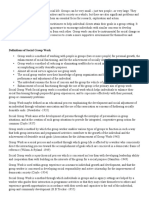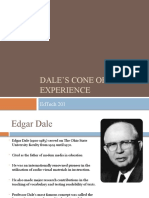Individual Differences, Mental Ability, and Personality
Individual Differences, Mental Ability, and Personality
Uploaded by
junar dacallosCopyright:
Available Formats
Individual Differences, Mental Ability, and Personality
Individual Differences, Mental Ability, and Personality
Uploaded by
junar dacallosOriginal Title
Copyright
Available Formats
Share this document
Did you find this document useful?
Is this content inappropriate?
Copyright:
Available Formats
Individual Differences, Mental Ability, and Personality
Individual Differences, Mental Ability, and Personality
Uploaded by
junar dacallosCopyright:
Available Formats
INDIVIDUAL DIFFERENCES, MENTAL ABILITY, AND PERSONALITY
INDIVIDUAL DIFFERENCES: the variation in how a. problem solving abilities
people respond to the same situation based
b. analytical skills
on personal characteristics.
c. competitive drive
CONSEQUENCES ARISING OUT OF INDIVIDUAL
DIFFERENCES d. motivation
1. Differences in productivity e. learning ability
2. Differences in the quality of their work f. sociability
3. Difference in how people react to CULTURE
empowerment.
Refers to the learned and shared ways
4. Difference in how people react to any style of people thinking and acting among a
of leadership. group of people or society.
5. Difference in terms of need for contrast with GENERATIONAL AND AGE-BASED DIFFERENCES
other people.
A worker that belongs to a certain
6. Difference in terms of commitment to the generation may behave differently from
org. a worker who belongs to another.
Differences in the ages of workers also
7. Difference in terms of level of self-esteem.
bring about expectations of differences
WHAT MAKES PEOPLE DIFFERENT FROM EACH in the behavior of workers.
OTHER? This is seen most often in age differences
since age is associated with experience.
A. REASONS WHY PEOPLE ARE DIFFERENT FROM
EACH OTHER TWO DIMENSIONS OF CULTURE
I. DEMOGRAPHICS A. SOCIAL CULTURE: social environment of
human-created beliefs, customs, knowledge,
>Gender
and practices that define conventional
>Generational differences & age behavior in a society.
>Culture B. ORGANIZATIONAL CULTURE: set of values,
beliefs and norms that is shared among
II. APTITUDE AND ABILITY members of an organization.
>Intellectual Ability APTITUDE AND ABILITY
>Physical Ability APTITUDE: the capacity of a person to learn or
III. PERSONALITY acquire skills.
>Physical characteristics ABILITY: refers to an individual’s capacity to
perform the various tasks in a job.
>Mental characteristics
FACTORS OF A PERSON’S OVERALL ABILITIES
DEMOGRAPHIC DIVERSITY
PHYSICAL ABILITIES: the capacity of the
Gender Differences: The differences in the individual to do tasks demanding stamina,
perception of male and female roles. dexterity, strength, and similar characteristics.
Men and women are not different along
the ff. concerns:
INDIVIDUAL DIFFERENCES, MENTAL ABILITY, AND PERSONALITY
MENTAL ABILITIES: the capacity to do mental behavior the same way that person’s
activities, such as thinking, reasoning, and compatriot would.
problem solving.
B. TRIARCHIC THEORY OF INTELLIGENCE- ROBERT
DIMENSION OF PHYSICAL ABILITY STERNBERG
A. DYNAMIC STRENGTH- ability to exert I. COMPONENTIAL/ANALYTICAL
muscular force repeatedly or continuously over INTELLIGENCE: involved components (or
time. mental processes) used in thinking; solving
difficult problems with abstract reasoning.
B. TRUNK STRENGTH: exert muscular strength
using the trunk (abdominal muscles) muscles. II. EXPERIENTIAL/CREATIVE INTELLIGENCE:
required for imagination and combining things
C. STATIC STRENGTH: to exert force against
in novel ways.
external objects.
III. CONTEXTUAL/PRACTICAL
D. EXPLOSIVE STRENGTH: ability to expend a
INTELLIGENCE: requires adapting to, selecting,
maximum of energy in one or a series of
and shaping our real-world environment;
explosive acts.
common sense, wisdom, and street smarts.
E. EXTENT FLEXIBILITY: ability to move the trunk
C. MULTIPLE INTELLIGENCE THEORY-HOWARD
and back muscles as far as possible.
GARDNER
F. DYNAMIC FLEXIBILITY: ability to make rapid,
I. LINGUISTIC: sensitive to language,
repeated flexing movements.
meanings, and the relations among words;
G. BODY COORDINATION: ability to coordinate able to communicate through language
the simultaneous actions of different parts of (writing, reading, and speaking)
the body.
II. LOGICAL/MATHEMATICAL: abstract
H. BALANCE: to maintain equilibrium despite thought, precision, counting, organization, and
forces pulling off balance. logical structure, enabling the individual to see
relationship bet. objects.
I. STAMINA: to continue maximum effort
requiring prolonged effort over time. III. MUSICAL: create and understand
meanings made out of sounds and to enjoy
COMPONENTS OF THE VARIOUS THEORIES OF different types of music.
INTELLIGENCE
IV. SPATIAL: enables people to perceive
A. DIMENSIONS OF INTELLECTUAL ABILITY and manipulate images in their brain and to
I. COGNITIVE: the capacity of a person re-create them from memory.
to acquire and apply knowledge including V. BODILY-KINESTHETIC: enables people
solving problems. to use their body and perceptual and motor
II. SOCIAL: person’s ability to relate systems in skilled ways.
effectively with others. VI. INTRAPERSONAL: highly accurate
III. EMOTIONAL: person’s qualities such understanding of himself or herself.
as understanding one’s own feelings, empathy VII. INTERPERSONAL: makes it possible for
for others, and the regulation of emotion to persons to recognize and make distinction
enhance living. among the feelings, motives, and intentions of
IV. CULTURAL: an outsider’s ability to others.
interpret someone’s unfamiliar and ambiguous
INDIVIDUAL DIFFERENCES, MENTAL ABILITY, AND PERSONALITY
VIII. NATURALIST: possesses the ability to 6. SELF-MONITORING BEHAVIOR: person’s ability
seek patterns in the external physical to adjust his/her behavior to external,
environment. situational, or environmental factors.
PERSONALITY: the sum total of ways in which 7. RISK TAKING AND THRILL SEEKING: person’s
an individual reacts and interacts with others. willingness to take risk and pursue thrills that
sometimes are required in the workplace.
“ways”= patterns of behavior that are
consistent and enduring. 8. OPTIMISM: tendency to experience positive
emotional states and to typically believe that
DETERMINANTS OF PERSONALITY
positive outcomes will be forthcoming from
HEREDITARY FACTORS: factors that are most activities.
determined at conception.
EMOTIONAL INTELLIGENCE/ EMOTIONAL
ENVIRONMENTAL FACTORS: exerts pressure on QUOTIENT
the formation of an individual’s personality.
- Introduced by DANIEL GOLEMAN
KINDS: - Ability of the person to accurately
perceive, evaluate, and express, and
1. CULTURAL: established norms, regulate emotions and feelings.
attitudes, and values that are passed along
from one generation to the next and creates FIVE COMPONENTS OF EQ
consistency over time
a. SELF-REGULATION: ability to calm down
2. SOCIAL: reflect family life, religions, anxiety, control impulsiveness, react
and the many kinds of formal and informal appropriately to anger.
groups in which the individual participates
b. MOTIVATION: passion to work for reason that
throughout his/her life.
go beyond money or status.
3. SITUATIONAL: indicate that the
c. EMPATHY: ability to respond to the unspoken
individual will behave differently in different
feelings of others.
situations.
d. SELF-AWARENESS: awareness of one’s own
KINDS OF PERSONALITY FACTORS AND TRAITS
personality or individuality
1. EMOTIONAL STABILITY: Characterizes one as
e. SOCIAL SKILLS: proficiency to manage
calm, self-confident, and secure; possesses a
relationships and building networks.
high degree of emotional stability can be
expected to withstand stress. More on physical ability:
2. EXTRAVERSION: who is sociable, gregarious, i. sense of sight: people differ in what they
assertive. actually see. (color blindness)
3. OPENNESS TO EXPERIENCE: a person who is ii. sense of hearing: people differ in their ability
imaginative, cultured, curious, original, broad- to hear (sharpness in listening to tones)
minded, intelligent, and artistically sensitive.
iii. sense of taste: a person’s tongue may be
4. AGREEABLENESS: person’s interpersonal sensitive to various tastes and this makes him or
orientation; an agreeable person is her different from another person who is less
cooperative, warm, and trusting. sensitive to taste.
5. CONSCIENTIOUSNESS: person’s reliability. iv. sense of smell: people have different
degrees of sensitivity to smell.
INDIVIDUAL DIFFERENCES, MENTAL ABILITY, AND PERSONALITY
v. sense of touch: people’s sense of touch may
differ in degree with another person’s.
You might also like
- Daily Lesson Log in Inquiries, Investigation, and Immersion THIRD QUARTER S.Y 2021-2022 Day/Date: March 02, 2022 Teacher: Nerissa R. AguilarDocument3 pagesDaily Lesson Log in Inquiries, Investigation, and Immersion THIRD QUARTER S.Y 2021-2022 Day/Date: March 02, 2022 Teacher: Nerissa R. AguilarNerissa Aguilar88% (8)
- Pro El 2 - Chapter 1Document3 pagesPro El 2 - Chapter 1Jpzelle100% (1)
- MGG 2016 Scorecard - English PDFDocument1 pageMGG 2016 Scorecard - English PDFThe Movement for Good Governance (MGG)No ratings yet
- Lesson 3 The Self As Cognitive ConstructDocument25 pagesLesson 3 The Self As Cognitive ConstructIvy Canonio Gallardo100% (3)
- Individual Differences, Mental Ability & Personality by Elino-jakiya-pa213-PresentationDocument50 pagesIndividual Differences, Mental Ability & Personality by Elino-jakiya-pa213-PresentationRafsanjani AbasNo ratings yet
- Individual Differences, Mental Ability, and PersonalityDocument6 pagesIndividual Differences, Mental Ability, and PersonalityPrince CalicaNo ratings yet
- Individual Differences, Mental Ability, and PersonalityDocument13 pagesIndividual Differences, Mental Ability, and PersonalityAce Maynard DiancoNo ratings yet
- A Moral Recovery ProgramDocument8 pagesA Moral Recovery ProgramNadhif Radiamoda Hadji NabelNo ratings yet
- Personal Spiritual LeadershipDocument7 pagesPersonal Spiritual Leadershipgejayan memanggilNo ratings yet
- Donations, Gifts and Sponsorships Model PolicyDocument5 pagesDonations, Gifts and Sponsorships Model Policyarchess pizonNo ratings yet
- Report On Diokno - The GreatDocument7 pagesReport On Diokno - The GreatmonaileNo ratings yet
- Psychosocial Activity: AUGUST 25-26, 2020Document47 pagesPsychosocial Activity: AUGUST 25-26, 2020Julibel ManceraNo ratings yet
- History of CoopDocument23 pagesHistory of CoopMarites Domingo - PaquibulanNo ratings yet
- Research Assignment On The Extent of E-Government Implementation in The PhilippinesDocument19 pagesResearch Assignment On The Extent of E-Government Implementation in The PhilippinesMa YaNo ratings yet
- Ethical Dilemmas & Social Responsibility IssuesDocument3 pagesEthical Dilemmas & Social Responsibility IssuesHector LambertNo ratings yet
- 2009 Revised Rules of Coa-Dir BoadoDocument64 pages2009 Revised Rules of Coa-Dir BoadoAbi Serrano TaguiamNo ratings yet
- Hbo Chapter 8Document29 pagesHbo Chapter 8Virginia MendozaNo ratings yet
- StressDocument26 pagesStressJaskaran Singh NarulaNo ratings yet
- LESSON 2 Values Development For CitizenshipDocument18 pagesLESSON 2 Values Development For CitizenshipLexydail Andrion BasilioNo ratings yet
- Chapter 2 Individual Behavior, Personality & ValuesDocument68 pagesChapter 2 Individual Behavior, Personality & ValuesSiti Sarah Zalikha Binti Umar BakiNo ratings yet
- Leading With People Part A1Document6 pagesLeading With People Part A1King Salman100% (1)
- Human Behavior in Organization Chapter 1 SummaryDocument1 pageHuman Behavior in Organization Chapter 1 SummaryYI Lie Suddenly ZhangNo ratings yet
- Certificate of AppearanceDocument1 pageCertificate of AppearanceLGU Talugtug, Nueva Ecija Mayor's Office100% (1)
- Transparency of Transaction and Access To InformationDocument4 pagesTransparency of Transaction and Access To InformationXernick Marquez FelipeNo ratings yet
- Values Attitudes and Job Satisfaction - Soumi RaiDocument29 pagesValues Attitudes and Job Satisfaction - Soumi RaiJay BadiyaniNo ratings yet
- Personality, Ability, Attitudes AND ValuesDocument35 pagesPersonality, Ability, Attitudes AND ValuesELISHA DIOLATANo ratings yet
- Case Study & ReflectionDocument4 pagesCase Study & ReflectionBernadette Ruth MasuliNo ratings yet
- The Nature and Challenge of Personnel Management FinalDocument116 pagesThe Nature and Challenge of Personnel Management FinalChickenNo ratings yet
- BSA3B - Activity - GAD LawsDocument3 pagesBSA3B - Activity - GAD LawsPhebe LagutaoNo ratings yet
- Capsulized Proposal MSU - Copy-1Document3 pagesCapsulized Proposal MSU - Copy-1Alibasher Macalnas100% (1)
- The Sangguniang Panlungsod Tasks and Responsibilities ChecklistDocument60 pagesThe Sangguniang Panlungsod Tasks and Responsibilities ChecklistOffice of Councilor Mark Anthony SantosNo ratings yet
- Is There A Difference Between Character and Personality?Document6 pagesIs There A Difference Between Character and Personality?S KY100% (1)
- Values Development For Citizenship TrainingDocument23 pagesValues Development For Citizenship TrainingDarkevil CasterNo ratings yet
- PpaDocument4 pagesPpaKyla JNo ratings yet
- Sample Format and Content Memorandum of UnderstandingDocument2 pagesSample Format and Content Memorandum of UnderstandingAsh TankNo ratings yet
- Changes in Personnel Status (Autorecovered)Document5 pagesChanges in Personnel Status (Autorecovered)Christine Joy RodriguezNo ratings yet
- Leadership and Decision-MakingDocument5 pagesLeadership and Decision-MakingThe AnonymousNo ratings yet
- Human Behavior-Lesson (Chapter 1 To 4)Document13 pagesHuman Behavior-Lesson (Chapter 1 To 4)Pasiphae Xinnea Clarkson100% (1)
- EO Mun Focal Person CSO PartnershipDocument1 pageEO Mun Focal Person CSO PartnershipAnonymous tlQd2LI100% (1)
- Nature of People: PA 251: Human Behavior in The OrganizationDocument48 pagesNature of People: PA 251: Human Behavior in The OrganizationBaisheigrid Pia AkmadNo ratings yet
- Special Report:: Working in The New Normal'Document42 pagesSpecial Report:: Working in The New Normal'Yashveer Takoory100% (1)
- Lesson 1 Organizational System and Human Behavior Human Behavior Goals of Organizational BehaviorDocument4 pagesLesson 1 Organizational System and Human Behavior Human Behavior Goals of Organizational Behaviorjennifer pagatpatanNo ratings yet
- GE 102 Ethics Module ChecklistDocument9 pagesGE 102 Ethics Module ChecklistArenas JenNo ratings yet
- CHAPTER 1 An Overview in Human Behavior in OrganizationsDocument11 pagesCHAPTER 1 An Overview in Human Behavior in OrganizationsJINNY CLAIRE VILLAROJONo ratings yet
- Human Behavior in Organization: Albert S. Dela CruzDocument69 pagesHuman Behavior in Organization: Albert S. Dela Cruzkathleenefay33% (3)
- Characteristics and Classifications of Values METIAM JAMES CESAR ADocument34 pagesCharacteristics and Classifications of Values METIAM JAMES CESAR ACeila BarataNo ratings yet
- Human Behavior in OrganizationDocument8 pagesHuman Behavior in OrganizationJanRalphBulanonNo ratings yet
- College of Teacher Education: Laoag City, Ilocos Norte, PhilippinesDocument1 pageCollege of Teacher Education: Laoag City, Ilocos Norte, PhilippinesSharmaine Frances D. AlcabedosNo ratings yet
- SOCIAL System and Organizational CultureDocument7 pagesSOCIAL System and Organizational CultureRenn TalensNo ratings yet
- Cooperative: An OverviewDocument27 pagesCooperative: An OverviewJanet T. CometaNo ratings yet
- Ethic and AccountabilityDocument3 pagesEthic and AccountabilityShahril BudimanNo ratings yet
- One-Way and Two-Way CommunicationDocument6 pagesOne-Way and Two-Way CommunicationRobell SamsonNo ratings yet
- Psychology and Mental Health - IV SemDocument19 pagesPsychology and Mental Health - IV SemSwarnaNo ratings yet
- Good Corporate GovernanceDocument3 pagesGood Corporate GovernanceRicoNo ratings yet
- Tahanan NG Kabataan NG LagunaDocument6 pagesTahanan NG Kabataan NG LagunaAnj Woods100% (1)
- Innovative LeadershipDocument14 pagesInnovative LeadershipRaselle NicolasNo ratings yet
- Chapter 2: Social PerceptionDocument19 pagesChapter 2: Social PerceptionArunkumar Murugadas100% (1)
- Chapter 3 - UTS (Anthropological Perspective)Document26 pagesChapter 3 - UTS (Anthropological Perspective)James CancinoNo ratings yet
- What Is Public PolicyDocument12 pagesWhat Is Public Policykaiser2cuNo ratings yet
- UN Convention On The Rights of The ChildDocument16 pagesUN Convention On The Rights of The Childkizumi987No ratings yet
- Hbo - Individual Differences, Mental Ability, and Personality Module 2Document33 pagesHbo - Individual Differences, Mental Ability, and Personality Module 2Marjon Dimafilis100% (1)
- HBO Module 1-2Document10 pagesHBO Module 1-2Chloie RagoNo ratings yet
- Techniques in Selecting and Organizing InformationDocument5 pagesTechniques in Selecting and Organizing InformationFaith MizukeNo ratings yet
- Mgt501 Mid Term by JuanidDocument32 pagesMgt501 Mid Term by JuanidShazia ManoNo ratings yet
- Purposive Communication: A. NetizensDocument4 pagesPurposive Communication: A. NetizensKen AlonzoNo ratings yet
- PretestDocument2 pagesPretestEunoia HalcyonNo ratings yet
- Chomsky's Language and MindDocument13 pagesChomsky's Language and Minddavidrojasv100% (1)
- Implication Variety of Socio - CultureDocument1 pageImplication Variety of Socio - CultureNur Muhammad KhalidNo ratings yet
- Summary PPT For PsycholinguisticsDocument3 pagesSummary PPT For PsycholinguisticsZano Elf100% (1)
- Intercultural Sensitivity and Target Language Acquisition of Overseas Filipino Workers in JapanDocument12 pagesIntercultural Sensitivity and Target Language Acquisition of Overseas Filipino Workers in JapanMarc Ivan PaleracioNo ratings yet
- Leadership Management Reflective EssayDocument4 pagesLeadership Management Reflective EssayLugo MarcusNo ratings yet
- Rubric For Presentation For CparDocument1 pageRubric For Presentation For Cparjhoana marie catiterNo ratings yet
- 'Preface' To Scaruffi The Nature of ConsciousnessDocument6 pages'Preface' To Scaruffi The Nature of ConsciousnessdrtengaNo ratings yet
- Philosophies of TeachingDocument29 pagesPhilosophies of TeachingJean LinatocNo ratings yet
- Nikopoulos 2004Document4 pagesNikopoulos 2004Alexandra DragomirNo ratings yet
- Case Study of A Child Age 10Document23 pagesCase Study of A Child Age 10api-511267301No ratings yet
- Chapter 1 - Preliminaries To Human Communication, de VitoDocument26 pagesChapter 1 - Preliminaries To Human Communication, de VitoStephanie Sobremesana100% (1)
- Storytelling To Improve Students' Speaking SkillDocument2 pagesStorytelling To Improve Students' Speaking SkillNovita Chusnul LiandaNo ratings yet
- RPP KD 3.3 Xii Lintas Minat - First Meeting Finite Non FiniteDocument1 pageRPP KD 3.3 Xii Lintas Minat - First Meeting Finite Non FiniteKhairul Umam HambaliNo ratings yet
- Practical No.2 - EDEDocument3 pagesPractical No.2 - EDE13TYCM-IOm DerleNo ratings yet
- Alternate Assignment For Field ObservationsDocument11 pagesAlternate Assignment For Field Observationsapi-549623622No ratings yet
- Detailed Lesson Plan (DLP) Format: Learning Competency/Ies: Code: Mt1Vcd-Iva-I-3.2Document10 pagesDetailed Lesson Plan (DLP) Format: Learning Competency/Ies: Code: Mt1Vcd-Iva-I-3.2Geralyn LavaNo ratings yet
- Perceptual Learning Style Preference Questionnaire AssignmentDocument3 pagesPerceptual Learning Style Preference Questionnaire AssignmentNoraini Danish AdnanNo ratings yet
- Definitions of Social Group WorkDocument23 pagesDefinitions of Social Group WorkRhen KhaNo ratings yet
- Dale's Cone of ExperienceDocument5 pagesDale's Cone of Experiencetrapkmeg16No ratings yet
- Distinction Between English and Bahasa Indonesia A PaperDocument9 pagesDistinction Between English and Bahasa Indonesia A PaperAgum FajarNo ratings yet
- Module I - Knowledge RepresentationDocument20 pagesModule I - Knowledge RepresentationFMFMFMFmNo ratings yet
- THE Rato Bangala School Early Childhood CenterDocument5 pagesTHE Rato Bangala School Early Childhood CenterRishi KarkiNo ratings yet
- Introducinng Social Psychology Tajfel and Fraser Introduction OnlyDocument15 pagesIntroducinng Social Psychology Tajfel and Fraser Introduction OnlyAditi GhoshNo ratings yet
- Lesson Plan in Review On Theories Related To The Learner's Development I. ObjectivesDocument5 pagesLesson Plan in Review On Theories Related To The Learner's Development I. ObjectivesBena Joy AbriaNo ratings yet

